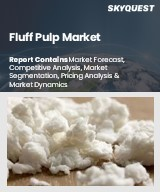
플러프 펄프 세계 시장 규모는 2023년에 102억 달러로 평가되었고, 2024년 106억 6,000만 달러에서 2032년에는 151억 6,000만 달러로 성장할 전망이며 예측기간(2025-2032년)의 CAGR은 4.5%로 예상됩니다.
세계의 플러프 펄프 시장은 신흥국 시장과 선진국 시장 모두에서 흡수성 위생 제품에 대한 수요가 높아지면서 강한 성장을 이루고 있습니다. 도시화, 가처분 소득 증가, 위생 의식 증가와 특히 월경 및 고령자 관리로 인해 이러한 제품에 대한 수요를 촉진하고 있습니다. 제조업체는 생산 능력을 확대하고 장섬유 침엽수를 조달하여 고품질 공급을 유지합니다. 시장을 형성하는 주요 동향은 지속 가능성을 추구하는 소비자와 규제 당국의 압력에 힘입은 지속 가능한 포장과 생분해성 제품으로의 전환입니다. 펄프 업계에서는 비용 절감과 환경 부하 저감을 위해 재생재나 환경친화적인 제법 등의 혁신이 진행되고 있습니다. 게다가, 특히 아시아태평양과 라틴아메리카에서는 모바일 건강관리 앱의 증가로 1인당 지출액의 상당한 성장에 기여할 것으로 예측됩니다.
Global Fluff Pulp Market size was valued at USD 10.2 billion in 2023 and is poised to grow from USD 10.66 billion in 2024 to USD 15.16 billion by 2032, growing at a CAGR of 4.5% during the forecast period (2025-2032).
The global fluff pulp market is witnessing robust growth fueled by rising demand for absorbent hygiene products across both developing and developed regions. Urbanization, increased disposable income, and heightened hygiene awareness, particularly around menstrual and senior care management, are driving the demand for these products. Manufacturers are expanding production capacities and sourcing long-fiber softwood to maintain quality supply. A key trend shaping the market is the shift toward sustainable packaging and biodegradable products, spurred by consumer and regulatory pressure for sustainability. Innovations in the pulp industry, including recycled materials and eco-friendly practices, are emerging to reduce costs and environmental impact. Furthermore, newer healthcare applications, particularly in Asia-Pacific and Latin America, are expected to contribute to significant growth in per-capita spending.
Top-down and bottom-up approaches were used to estimate and validate the size of the Global Fluff Pulp market and to estimate the size of various other dependent submarkets. The research methodology used to estimate the market size includes the following details: The key players in the market were identified through secondary research, and their market shares in the respective regions were determined through primary and secondary research. This entire procedure includes the study of the annual and financial reports of the top market players and extensive interviews for key insights from industry leaders such as CEOs, VPs, directors, and marketing executives. All percentage shares split, and breakdowns were determined using secondary sources and verified through Primary sources. All possible parameters that affect the markets covered in this research study have been accounted for, viewed in extensive detail, verified through primary research, and analyzed to get the final quantitative and qualitative data.
Global Fluff Pulp Market Segments Analysis
Global Fluff Pulp Market is segmented by Source, Grade, Application, End Use and region. Based on Source, the market is segmented into Loblolly Pine and Slash Pine. Based on Grade, the market is segmented into Untreated and Treated. Based on Application, the market is segmented into Absorbent Core Products, Feminine Hygiene Products and Other Applications. Based on End Use, the market is segmented into Disposable Diapers, Adult Incontinence, Feminine Hygiene, Air-Laid Products and Other End Uses. Based on region, the market is segmented into North America, Europe, Asia Pacific, Latin America and Middle East & Africa.
Driver of the Global Fluff Pulp Market
The global fluff pulp market is experiencing robust growth primarily driven by the surging demand for baby diapers, adult incontinence products, and feminine hygiene items. This trend is particularly influenced by rapid urbanization and increasing disposable incomes, particularly in the Asia Pacific region, where consumers are leaning towards convenience and hygiene. As a result, the consumption of fluff pulp for absorbent cores is on the rise. In response to this burgeoning demand, manufacturers are expanding their production capacities to meet contractual obligations with major brands in the hygiene product sector, establishing a foundation for sustained growth in the industry.
Restraints in the Global Fluff Pulp Market
The global fluff pulp market faces several significant constraints stemming from fluctuations in softwood log prices, which directly affect the pricing of bleached kraft fluff pulp. Natural disasters such as fires and hurricanes, along with geopolitical uncertainties, have contributed to this price variability. Additionally, changes in trade tariffs, particularly between the US and Canada regarding lumber, have introduced further instability, impacting producers' profit margins. As mills cope with rising costs, they may be forced to pass these expenses onto customers or risk narrowing their profit margins. Moreover, unpredictable material costs can hinder producers' ability to meet demand, ultimately affecting production forecasts and competitiveness within the market.
Market Trends of the Global Fluff Pulp Market
The global fluff pulp market is witnessing a significant shift towards sustainability, with manufacturers prioritizing the sourcing of certified wood, such as FSC- or PEFC-certified materials, in response to rising consumer demand for eco-friendly hygiene products. This trend is further fueled by stringent environmental regulations promoting biodegradable alternatives, including agricultural residues and bamboo. Consequently, fluff pulp producers are investing in provenance tracking and eco-labeling initiatives, alongside implementing closed-loop water treatment systems to minimize environmental impact. Brands are capitalizing on this movement by marketing sustainable products, such as eco-friendly diapers and medical dressings, thus driving innovation and commitment to low-impact pulping practices across the industry.